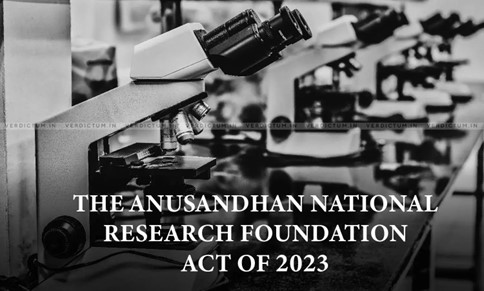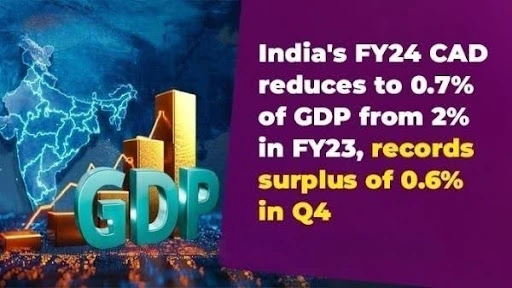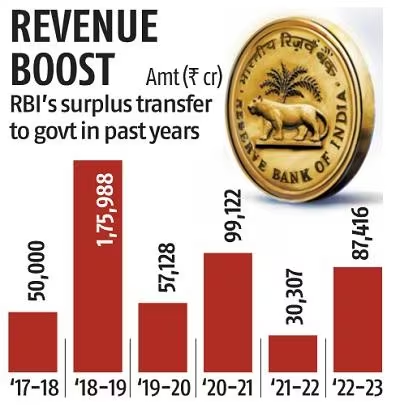Wednesday, 10th July 2024
Draft Digital Competition Bill
Why in the News?
- In February 2023, the Ministry of Corporate Affairs (MCA) formed the Committee on Digital Competition Law (CDCL) to explore the necessity of a separate law addressing competition in digital markets.
- After a year of discussions, the CDCL concluded that the existing Competition Act, 2002, which operates on an ex-post framework, needed to be supplemented with an ex-ante framework.

- The European Union is the only jurisdiction where a comprehensive ex-ante competition framework, under the Digital Markets Act, is currently in force.
- This led to the creation of the draft Digital Competition Bill, which outlines the ex-ante framework designed to enhance the current regulatory system for digital markets.
Growing Need for an Ex-Ante Framework:
- Due to the complex world of digital markets, regulating market abuse after it takes place (as in an ex-post framework) is not optimal. This is due to the following reasons:
- Economies of Scale and Scope:
- Digital enterprises benefit from reductions in production costs per unit as the number of units increase and reductions in total costs of production with an increase in the number of services, respectively.
- This allows them to grow rapidly compared to traditional market players.
- Network Effects:
- The utility of digital services increases with the number of users, propelling growth further.
- Preventive Regulation:
- A forward-looking, preventive, and presumptive law (an ex-ante framework) that foresees potential harms arising from antitrust issues and prescribes pre-determined no-go areas is considered the way forward.
About the Digital Competition Bill, 2024:
- About:
- The bill seeks to further regulate large digital enterprises, including news aggregators, to ensure a level-playing field and fair competition in the digital space.
- Proposed in March 2024, the new law aims to prevent big tech companies like Google, Facebook, and Amazon from favouring their own services or using data collected from one of their businesses to help another one of their businesses.
- It includes provisions to set presumptive norms to curb anti-competitive practices before they occur and promises to impose heavy penalties — potentially amounting to billions of dollars — for violations.
- Similarity with EU’s Digital Markets Act (DMA):
- The DMA went into complete effect earlier this year and requires large tech firms like Alphabet, Amazon, and Apple to open their services and not favour their own services at the expense of rivals.
- Nodal Ministry:
- The Ministry of Corporate Affairs (MCA) is handling the draft.
Key Proposals of the Draft Digital Competition Bill, 2024:
- List of Core Digital Services (CDS): The list of core digital services is mentioned under Schedule I of the bill. It includes:
- Online search engines
- Online social networking services
- Video-sharing platform services
- Interpersonal communications services
- Operating systems
- Web browsers
- Cloud services
- Advertising services
- Online intermediation services (such as web-hosting, service providers, payment sites, auction sites, app stores, e-commerce marketplaces, and aggregators)
- Significant Entities:
- The Bill proposes to designate certain enterprises as Systemically Significant Digital Enterprises (SSDEs). These are enterprises that:
- Provide core digital services in India
- Have significant presence and financial strength in the country
- Parameters to Determine SSDEs:
- If an enterprise is engaged in a CDS, the Bill proposes two tests — the financial strength test and spread test (user base test) — to determine SSDE designation. The quantitative parameters include:
- Turnover in India not less than Rs 4,000 crore in the last 3 financial years, or global turnover not less than $30 billion
- Gross merchandise value in India not less than Rs 16,000 crore
- Global market capitalization not less than $75 billion
- Core digital service provided by the company should have at least 1 crore end users or 10,000 business users
- Entities not meeting these parameters can still be designated as SSDEs if the Competition Commission of India (CCI) believes they have a significant presence in any core digital service.
- Obligations Imposed on SSDEs:
- SSDEs are prohibited from engaging in practices such as:
- Self-preferencing
- Anti-steering
- Restricting third-party applications
- Violations can result in fines up to 10% of their global turnover.
- SSDEs are prohibited from engaging in practices such as:
- Associate Digital Enterprises (ADEs):
- The Bill proposes to designate associate digital enterprises (ADEs) to understand the role that data collected by one company in a major technology group can play in benefiting other group companies.
- Obligations for ADEs will depend on their involvement with the core digital service offered by the main company.
- For example, Google Maps could be seen as an associate entity because Google Search directs users to it, and YouTube based on data sharing between Google Search and YouTube.
Criticism of the Digital Competition Bill, 2024:
- Significant Compliance Burden:
- An ex-ante framework with strict prescriptive norms could lead to a significant compliance burden for big tech companies.
- It may shift the focus from innovation and research to ensuring that companies do not presumptively engage in anti-competitive practices.
- Stringent Requirements of the EU’s DMA and Associated Impact:
- Experts have noted a significant increase in the time it takes to find information via Google search under the EU’s DMA.
- Broad Definition of Significant Platform:
- Companies are concerned about the broad definition — both quantitative and qualitative — of who a significant platform could be.
- Unlike the EU’s DMA, which specifically names ‘gatekeeper’ entities, the draft law in India leaves this decision to the discretion of the CCI.
- This could lead to arbitrary decision-making and potentially impact start-ups.
- Impact on Smaller Businesses:
- The bill might force companies to make platform changes and cut down on data sharing.
- This could impact smaller businesses that rely on these platforms to reach a large target audience.
Source: TH
Defamation Case Against Wikipedia
Why in the News?
- Recently, News agency Asian News International (ANI) has filed a lawsuit in Delhi High Court against Wikipedia, alleging defamatory content on ANI’s wiki page.

Background of the Case:
- Complaint Against Wikipedia
- Allegations: ANI claims the content on its Wikipedia page is false and defamatory, harming its reputation.
- Edit History: ANI states that factual corrections made in April were reversed in May, causing reputational damage.
- Damages Sought: ANI is seeking Rs 2 crore in damages.
- Suit Against Wikipedia, Not an Individual
- Wikipedia's Nature: Wikipedia, founded in 2001, is a nonprofit, open-source platform where users contribute content.
- Intermediary Liability: The lawsuit targets Wikipedia as an intermediary, aiming to enforce accountability.
- Laws Invoked in the Case
- Significant Social Media Intermediary (SSMI): ANI argues Wikipedia is an SSMI under Section 2(1)(w) of the IT Act, 2000, having more than 5 million registered users in India.
- Sections 79(2) & (3): These sections outline the conditions for the "safe harbour clause."
The Safe Harbour Clause of IT Act:
- Section 79 of the IT Act
- Immunity from Liability: Intermediaries are not liable for third-party content if specific conditions are met.
- Conditions for Immunity:
- Non-Involvement: Intermediaries must not initiate, select the receiver, or modify the transmission.
- Compliance: Must comply with due diligence and the Intermediary Guidelines and Digital Media Ethics Code of 2021.
- Immunity from Liability: Intermediaries are not liable for third-party content if specific conditions are met.
- Grievance Redressal Mechanism
- Intermediaries must establish a grievance redressal system, appointing a resident grievance officer, a chief compliance officer, and a nodal contact person.
- Action Upon Notice
- Immunity is void if intermediaries fail to remove illegal content after government notification or tamper with evidence.
- Loss of Safe Harbour Status
- Rule 7 of the IT Rules, 2021: Non-compliance results in the loss of safe harbour protection, exposing intermediaries to legal liability.
Various SC Judgements on the Issue:
- Ayurvedic Medicine Manufacturers Organisation of India Case (2022)
- Petition Rejected: SC rejected petitions about a defamatory article published online.
- Suggestion: The court suggested editing the Wikipedia article and exploring other legal options.
- Hewlett Packard India Sales vs. Commissioner of Customs (January 2023)
- Recognition: SC acknowledged authorities using Wikipedia for decisions but warned against its reliability for legal matters due to user-generated content.
|
UPSC Civil Services Examination, Previous Year Question (PYQ): Mains Q:1 What do you understand about the concept of “freedom of speech and expression”? Does it cover hate speech also? Why do the films in India stand on a slightly different plane from other forms of expression? Discuss. (2014) |
Source: IE
UNESCO Designates 11 New Biosphere Reserves
Why in the news ?
- Recently, UNESCO has approved the designation of 11 new biosphere reserves in 11 countries, including Belgium and Gambia for the first time and two transboundary biosphere reserves.
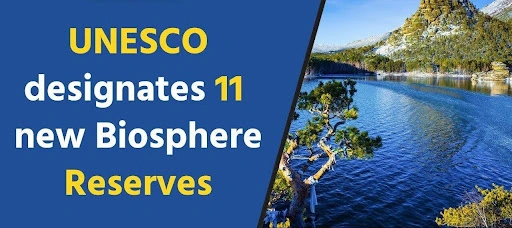
- New biosphere reserves covering a total area of 37 400 km², the World Network of Biosphere Reserves now totals 759 sites in 136 countries with 275 million people worldwide.
- India has 18 biosphere reserves, 12 of which are recognized under this program, with the Nilgiri Biosphere Reserve being the first.
What are the new additions to the UNESCO Biosphere Reserve List?
- Kempen-Broek Transboundary Biosphere Reserve (Belgium, Kingdom of the Netherlands)
- Location: Low-lying terrain shared between Belgium and the Netherlands.
- Area: 264 km²
- Population: Approximately 75,000
- Features: Wetlands transformed into farmlands with remnants of marshes, diverse bird species, and historical sites.
- Darién Norte Chocoano Biosphere Reserve (Colombia)
- Location: Darien ecoregion, connecting North and South America.
- Area: 3,016 km² (including marine areas)
- Population: 24,287, predominantly Indigenous Peoples and Afro-Colombian origins.
- Features: Tropical rainforests, marine areas, historical settlements, and diverse wildlife including the harpy eagle.
- Madre de las Aguas Biosphere Reserve (Dominican Republic)
- Location: Heart of the Dominican Republic, spanning 11 provinces and 35 municipalities.
- Area: 9,374 km²
- Population: 472,526
- Features: Diverse topography shaped by the Cordillera Central, waterfalls, and rich avian biodiversity.
- Niumi Biosphere Reserve (Gambia)
- Location: North bank of the Gambia River, adjacent to Senegal’s Delta de Saloum Biosphere Reserve.
- Area: 1,937 km²
- Population: Approximately 178,000
- Features: Mangroves, red limestone formations, Ramsar wetland, and historical sites.
- Colli Euganei Biosphere Reserve (Italy)
- Location: Veneto region, northeastern Italy.
- Area: 341 km²
- Population: 111,368
- Features: Volcanic hills, thermal spas, olive groves, vineyards, and diverse flora and fauna.
- Julian Alps Transboundary Biosphere Reserve (Italy, Slovenia)
- Location: Alpine mountains and karst plateaux spanning Slovenia and Italy.
- Area: 2,671 km² (including core, buffer, and transition zones)
- Population: 109,060 across 20 municipalities
- Features: Alpine biodiversity, brown bears, lynxes, and participatory planning involving 176 institutions.
- Khar Us Lake Biosphere Reserve (Mongolia)
- Location: Western Mongolia, Great Lake basin in Khovd Province.
- Area: 14,153 km²
- Population: Local ethnic groups, engaged in sustainable animal husbandry.
- Features: Diverse ecosystems including aquatic realms, deserts, mountains, and steppe landscapes.
- Apayaos Biosphere Reserve (Philippines)
- Location: Apayao Province, Philippines.
- Area: 3,960 km²
- Population: 124,366
- Features: Rugged terrain, Apayao River watershed, Indigenous Cultural Communities, and high biodiversity.
- Changnyeong Biosphere Reserve (Republic of Korea)
- Location: Gyeongsangnam-do Province, central northern region.
- Area: 531 km²
- Population: Majority in transition area and buffer zone.
- Features: Mount Hua Wang forests, Upo Wetland, agricultural croplands, and conservation efforts for crested ibis.
- Val d'Aran Biosphere Reserve (Spain)
- Location: Western Catalan Pyrenees, Catalonia, Spain.
- Area: 632 km²
- Population: 9,983
- Features: Watershed between Mediterranean and Atlantic realms, Occitan cultural heritage, and biodiversity conservation.
- Irati Biosphere Reserve (Spain)
- Location: Western Pyrenees, Navarre, Spain.
- Area: 537 km²
- Population: 2,435
- Features: Beech forests, community-driven conservation, and diverse stakeholder engagement.
What are Biosphere Reserves?
- Biosphere Reserves are areas designated under UNESCO's Man and the Biosphere (MAB) Programme to promote sustainable development and conservation of biodiversity.
- The Man and Biosphere (MAB) Programme, launched in 1971, is an international scientific initiative that aims to foster a harmonious relationship between humans and their environment.
Characteristics of Biosphere Reserves:
- Designation: Designated by the Director-General of UNESCO following decisions of the MAB International Coordinating Council (MAB ICC).
- Integration: They integrate conservation, sustainable development, and logistical support functions to promote a balanced relationship between humans and the environment.
- Functions:
- Conservation: Protects biodiversity and cultural diversity, including landscapes, ecosystems, species, and genetic variation.
- Sustainable Development: Supports socio-culturally and environmentally sustainable economic activities.
- Logistic Support: Facilitates research, monitoring, education, and training related to sustainable development and biodiversity conservation.
Zones within Biosphere Reserves:
- Core Areas:
- Strictly protected zones aimed at conserving landscapes, ecosystems, species, and genetic diversity.
- Activities are limited to scientific research, monitoring, and conservation management.
- Buffer Zones:
- Surrounds or adjoins the core area.
- Used for activities that are compatible with sustainable ecological practices, such as limited human activities that support research, monitoring, training, and education.
- Transition Areas:
- Outermost zone where human activities are conducted.
- Focuses on fostering socio-culturally and ecologically sustainable economic activities.
- Includes communities engaged in agriculture, tourism, and other sustainable practices that support local livelihoods while conserving natural resources.
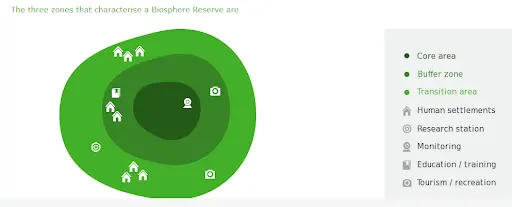
The significance of biosphere reserves:
- Scientific Role: Biosphere reserves are vital for scientific research, providing insights into ecological processes and human impacts on ecosystems.
- Environmental Management: They contribute data for informed environmental policies and management decisions, aiding in biodiversity conservation and sustainable resource use.
- Global Goals: Biosphere reserves support global biodiversity targets by protecting and restoring ecosystems crucial for biodiversity and human well-being.
- Local Development: They promote sustainable local development through activities like ecotourism and sustainable agriculture, balancing economic benefits with environmental conservation.
- Climate Action: Biosphere reserves help mitigate climate change by storing carbon, regulating climate patterns, and enhancing resilience against climate impacts through ecosystem conservation and sustainable practices.
|
UPSC Civil Services Examination, Previous Year’s Question (PYQs) Prelims Q.1 Consider the following pairs: (2013)
Which of the above pairs is/are correctly matched?
Ans: (a) Q.2 The most important strategy for the conservation of biodiversity together with traditional human life is the establishment of (2014)
Ans: (a) Q.3 Out of all the Biosphere Reserves in India, four have been recognized on the World Network by UNESCO. Which one of the following is not one of them? (2008)
Ans: (b) |
Russia’s ‘high income’ rating despite sanctions
Why in the news ?
- The World Bank has upgraded Russia from an ‘upper-middle income’ country to a ‘high-income’ one, a status it last had in 2014.
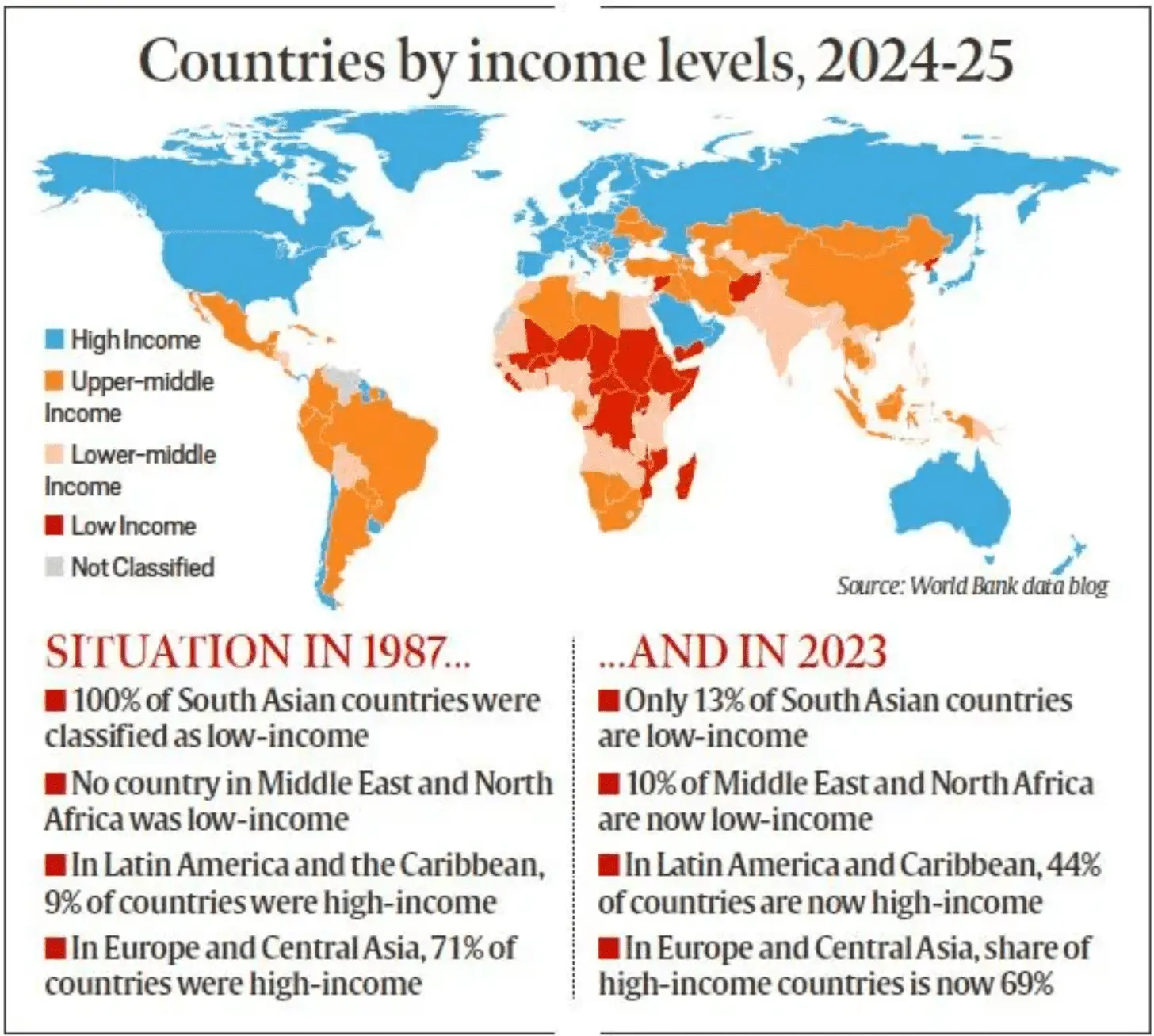
Russia’s economic resilience:
- In nominal terms, Russia ranks 72nd globally in per-capita GNI and 53rd in purchasing power parity.
- The increase in real (3.6%) and nominal (10.9%) GDP was caused by growth in trade (+6.8%), the financial sector (+8.7%), and construction (+6.6%).
- The World Bank suggested that economic activity in Russia was influenced by a large increase in military-related activity in 2023.
Why didn't the sanctions work?
- Oil and gas exports: Sanctions on Russia are not as stringent as they were on Iran or Venezuela. Russia’s fossil fuel exports to Western Europe have fallen, but export volumes have remained relatively steady.
- Investment: It has recovered from the drop in 2022, adding an estimated 4.5 percentage points to the growth in GDP in 2023, mainly due to:
- Increased resources flowing to the country’s defence and manufacturing sectors.
- Domestic goods are substituting some imports, resulting in investments in new production facilities.
- Some MNCs have stayed back, hoping the war will end and sanctions will be lifted.
- Consumption: Recovery in private consumption added 2.9 percentage points to GDP growth driven by buoyant credit and a strong labour market (unemployment rate only 3%).
- Monetary incentives for military recruitment have let consumers carry on with their spending.
- Government spending: Fiscal impulse estimated at 1.2 percentage points of GDP in 2023. Defence spending in Russia has been ramped up to an estimated 7% of GDP.
- Sanction manoeuvre: Learning from past sanctions, Russian policymakers have learned to manoeuvre around these punitive measures.
- Central Bank role: Hawkish monetary policies of the Russian central bank also stimulated the economy.
World Bank’s income rankings:
- The World Bank classifies countries into four groups based on per-capita gross national income (GNI) in US dollars: low, lower-middle, upper-middle, and high.
- Criteria for high-income countries: $14,005 or more per person.
- Russia, Bulgaria and Palau upgraded their status to “high-income countries“.
Improvement in Ukraine’s ranking:
- Ukraine improved its status from a lower-middle-income country to an upper-middle-income country.
- However, this was purely because of the base effect and a resumption of economic activity in the country’s western and northern parts, partly due to the war.
Source: (IE)
Kalasa-Banduri project
Why in the news ?
- A team from the Progressive River Authority for Water and Harmony (PRAWAH), the central authority for the Mahadayi River, visited Belagavi district in Karnataka.
- They discussed the Kalasa and Banduri projects in detail, including survey plans.

Mahadayi River Dispute:
- Origin of Conflict: The dispute began in 1985 when Karnataka proposed a 350-megawatt hydroelectric project that aimed to divert more than 50% of the river's water for irrigation purposes.
- Goa's Opposition: Goa, as the downstream state, has consistently opposed Karnataka's plan to divert Mahadayi River water.
- Establishment of Mahadayi Water Tribunal: In 2010, the Mahadayi Water Tribunal was set up under the Interstate River Water Disputes Act to adjudicate on water sharing issues among the states.
- Water Allocation: In 2018, the tribunal allocated water usage quotas among the three states: Goa (24 tmcft), Karnataka (5.4 tmcft), and Maharashtra (1.33 tmcft). Karnataka challenged this allocation in the Supreme Court.
- Supreme Court Intervention: Karnataka was granted permission by the Supreme Court to draw additional water for power generation, but due to ongoing disputes, Karnataka has not received any allocated water.
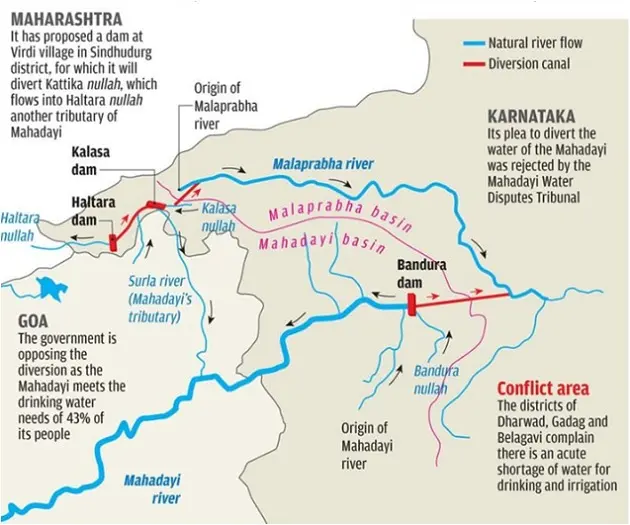
Environmental Concerns and Project Revisions:
- Goa expresses concerns about deforestation resulting from the project.
- Karnataka has revised its project report to minimise forest impact and ensure reforestation.
- Despite reports indicating no tiger presence in Kankumbi forest by the National Tiger Conservation Authority, Goa claims the project could impact tiger conservation.
- The PRAWAH team's visit aims to assess Karnataka's construction progress, gather information on natural water flow, and verify claims related to tiger reserves.
Kalasa-Banduri Project:
- The Karnataka government's Kalasa-Banduri Project proposes diverting water from the Mandovi River via Kalasa and Banduri canals into the Malaprabha River.
- It aims to provide drinking water to parts of four districts: Dharwad, Belagavi, Bagalkot, and Gadag.
- The project entails constructing 11 dams on the Mandovi River.
- Goa asserts that the project threatens the Western Ghats, a mega biodiversity hotspot, by affecting macronutrient flow and impacting flora and fauna in the Mahadayi Wildlife Sanctuary.
- Additionally, Goa argues that the diversion could increase tidal base water, impacting Surla River residents and depleting underground water sources.
Source: (DTE)
Spotted Hyenas Outcompeting Leopards
Why in the news ?
- Spotted hyenas are increasingly out-competing leopards in a Tanzanian protected area.
- Concern: This could disrupt ecosystem balance, potentially leading to overpopulation of prey species normally controlled by leopards.

Reasons for Spotted Hyenas Outcompeting Leopards:
- Social Structure: Spotted hyenas live in groups called ‘clans’ or ‘cackles’, which enable cooperative hunting and defence strategies. But leopards are solitary animals except during mating season.
- Human Tolerance: Hyenas are tolerated by local communities because they scavenge on dead or sick livestock and generally avoid conflict with humans. In contrast, leopards are often hunted or prosecuted for attacking livestock and occasionally threatening human safety.
- Kleptoparasitism: Hyenas are ‘kleptoparasitic‘, stealing kills from other predators, including leopards. This allows them to gain food without spending energy on hunting, giving them a competitive edge.
- Size and Physical Competition: Larger, more powerful male leopards can defend against hyenas. But they must give way to their rivals in human-dominated areas with richer resources.
- Behaviour Change: Female leopards are smaller than males and more vulnerable to hyenas. So, female leopards completely change their behaviour and become diurnal, as hyenas are nocturnal.
- Adaptability: Hyenas are adaptable to various environmental conditions and human-altered landscapes.
Spotted Hyena or Laughing Hyena
- One of Africa’s most successful hunters. They are the largest of three hyena species in the world.
- Distribution: They are found across sub-Saharan Africa.
- Habitat: They inhabit various habitats, from savannas and grasslands to forest edges.
- They live in large groups called clans (up to 80 individuals), led by females.
- Have good hearing and sharp eyesight at night. Fast runners and can run for long distances without tiring.
- Known for strong jaws & ability to crush bones. Make various sounds, including the distinctive “laughing”.
- Conservation Status: IUCN: LC
Source: (DTE)
Brown Palm Civet (Paradoxurus jerdoni)
Why in the news ?
- A rare brown palm civet was recently seen in the Koyna Wildlife Sanctuary.
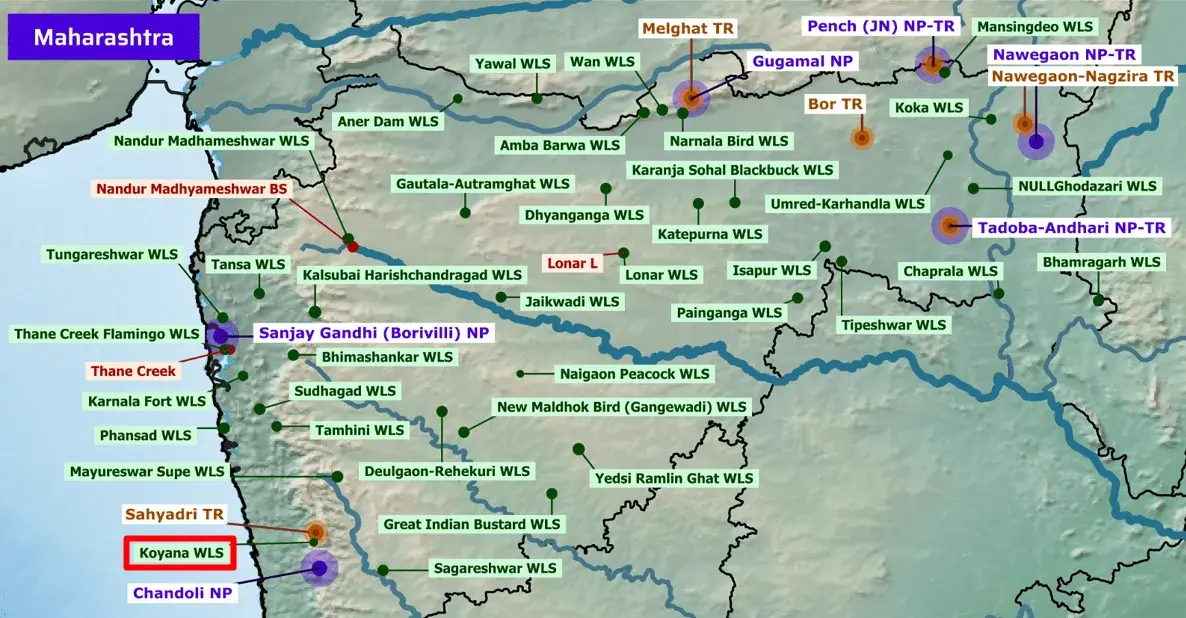
- The brown palm civet (Paradoxurus jerdoni), also known as Jerdon’s palm civet, is a species endemic to the Western Ghats of India.
- Physical Description: It is characterised by a uniformly brown fur coat, darker around the head, neck, shoulders, legs, and tail. Unlike other civets, it lacks distinct facial markings. A notable feature is the reversed direction of hair growth on the nape, similar to the golden palm civet.
- Distribution: Found from Castle Rock in Goa to the southern end of the Western Ghats in Kalakkad Mundanthurai Tiger Reserve.
- Habitat: Brown palm civets are nocturnal and arboreal, thriving in the high-altitude tropical rainforests of the Western Ghats. They prefer habitats ranging from 500 to 1,300 metres above sea level.
- Diet: They are primarily frugivorous, with fruits making up about 97% of their diet.
- Conservation Status: Classified as Least Concern by the IUCN and listed under Appendix III of CITES, indicating it may benefit from international cooperation in its management.
- Ecological Significance: These civets play a crucial role in seed dispersal across the Western Ghats, aiding in forest regeneration even in fragmented habitat

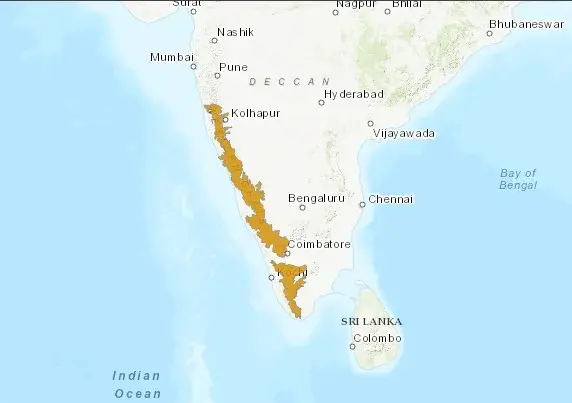
Source: (PJ)
Veerangana Durgavati Tiger Reserve
Why in the news ?
- The Madhya Pradesh government has initiated an inquiry into the alleged poaching of tigers and irregularities in the newly established Veerangana Durgavati Tiger Reserve.
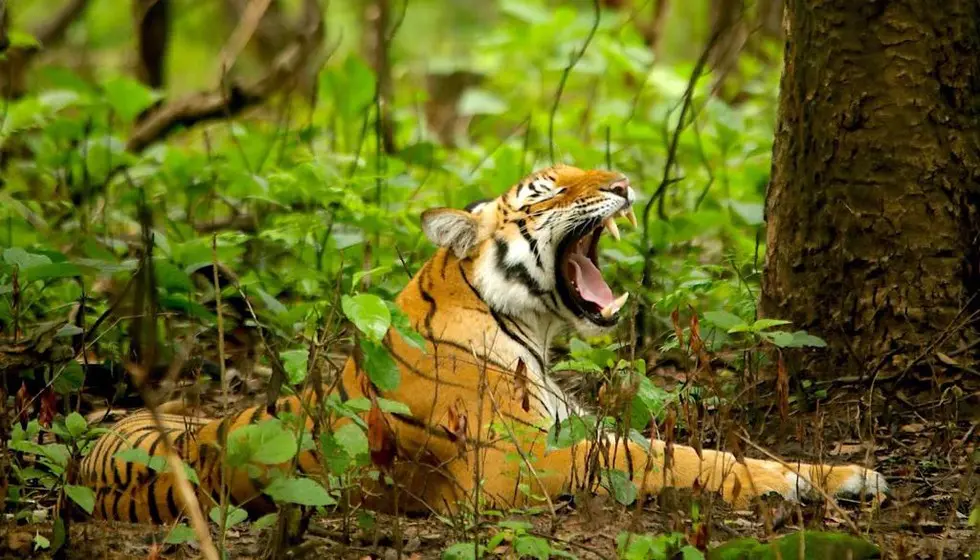
About Veerangana Durgavati Tiger Reserve:
- Location: It is spread across Sagar, Damoh, and Narsinghpur districts of Madhya Pradesh.
- Area: Covering an expansive 2,339 square kilometres, it encompasses areas within the Nauradehi Wildlife Sanctuary and Durgavati Wildlife Sanctuary.
- Status: It is the seventh tiger reserve in Madhya Pradesh.
- Name: Named after Rani Durgavati, the queen of the Gondi people.
- Landscape: The reserve boasts a diverse landscape, including hills, valleys, rivers, streams, waterfalls, and grasslands.
- Rivers: It straddles parts of the Narmada and Yamuna River basins.
- Historic Site: The Singorgarh Fort is located within the reserve.
- Vegetation: Dry deciduous type.
- Flora: Key floral elements include Teak, Saja, Dhaora, Ber, Amla, etc.
- Fauna:
- Mammals: Tiger, leopard, wolf, jackal, Indian fox, striped hyena, Nilgai, Chinkara, Chital, Sambhar, Black Buck, Barking deer, Rhesus Macaque, etc.
- Raptors: One of the few remaining strongholds for the White-Rumped and Indian Vultures, critically endangered species in India.
- Green Corridor: A green corridor linking Panna Tiger Reserve (PTR) with Durgavati will be developed to facilitate the natural movement of tigers to the new reserve.
Source: TP
Anand Marriage Act
Why in the news ?
- Recently, the National Commission for Minorities held a meeting chaired by its Chairman with representatives from 18 States/UTs to discuss the implementation and registration of Sikh marriages under the Anand Marriage Act.

About Anand Marriage Act:
- Purpose: Provides statutory recognition of marriage rituals of the Sikh community in India.
- Historical Background: The Act originated in 1909 when the British Imperial Legislative Council passed legislation recognizing the Sikh wedding ceremony, Anand Karaj.
- Objective: Aimed to acknowledge and respect Sikh customs and practices.
- Amendment: In 2012, Parliament passed the Anand Marriage (Amendment) Bill, granting legal recognition to Sikh traditional marriages.
- Implementation: While the central government approved the amendments, individual states and union territories were tasked with framing specific rules for registering Anand marriages.
Significance of the Act:
- Provides statutory recognition to Sikh marriage rituals.
- Fulfils the Sikh community's long-standing demand to solemnise their marriages without resorting to the Hindu Marriage Act.
Recent Implementation:
- The 'Jammu and Kashmir Anand Marriage Registration Rules, 2023' have been established for registering "Anand marriages."
- Under these rules, tehsildars will serve as the registrars for such marriages within their respective jurisdictions, according to a government notification issued.
Source: PIB
India Needs to Reset Its Trade Policy
Context:
- India's resistance to expanding the World Trade Organisation’s (WTO) negotiation agenda, especially in areas like e-commerce, trade, climate change, and investment facilitation, has sparked considerable debate.
- India's stance on preserving policy flexibility benefits traditional sectors like agriculture and fisheries but may hinder capitalising on opportunities in the digital economy and high-tech manufacturing, crucial to its Vikas Bharat vision.

Reason Behind India's Resistance to WTO Expansion and Its Drawbacks:
- To Maintain Policy Flexibility:
- India’s resistance to the WTO’s expanded negotiation agenda is primarily to maintain policy flexibility for its economic development strategies.
- This cautious approach benefits traditional sectors such as agriculture and fisheries, where policy autonomy is crucial to protect the livelihoods of millions of small farmers and fishermen.
- These sectors are highly sensitive to international competition and volatile global markets, necessitating a protective stance to ensure food security and sustainable rural development.
- Drawbacks of India’s Resistance:
- India’s resistance to liberalising trade policies can have significant drawbacks, particularly in seizing new opportunities in the digital economy and high-tech manufacturing.
- These sectors are rapidly transforming the global economic landscape, driven by advancements in technology, innovation, and the increasing integration of digital platforms in business operations.
- The digital economy encompasses a broad range of activities, including e-commerce, digital services, fintech, and artificial intelligence, all of which present immense growth potential for India.
- Therefore, India’s stance against the WTO’s expansion could hinder the realisation of its Vision 2047.
Key Components of India’s Vision 2047:
- Digital Infrastructure Development
- Internet Connectivity: Aim for 100% broadband coverage across rural and urban areas by 2030.
- Data Centers: Establish multiple advanced data centres to support growing data needs.
- Digital Payment Systems: Increase digital payment transactions to $1 trillion annually by 2030.
- Innovation and R&D
- R&D Investment: Increase R&D spending to 2.5% of GDP by 2047.
- Startups: Support the growth of 100,000 tech startups by 2047.
- Technology Advancements: Focus on developing AI, biotechnology, and quantum computing technologies.
- Skilled Workforce
- Educational Reforms: Revamp curricula to include emerging technologies and digital skills.
- Vocational Training: Provide vocational training programs for 50 million people by 2030.
- Upskilling Initiatives: Launch programs to upskill the existing workforce in digital and high-tech sectors.
- Regulatory Reforms
- Ease of Doing Business: Aim to be in the top 25 of the World Bank's Ease of Doing Business ranking by 2030.
- Data Protection: Implement data protection regulations aligned with global standards by 2025.
- Foreign Investment: Create a conducive environment to attract $100 billion in FDI annually by 2030.
- Sustainable Development
- Green Technologies: Invest in renewable energy to achieve 500 GW of installed capacity by 2040.
- Carbon Emissions: Reduce carbon emissions to achieve net-zero by 2070.
- Environmental Sustainability: Promote sustainable practices in agriculture, manufacturing, and urban development to ensure long-term environmental health.
Why India Needs to Reset Its Trade Policy:
- To Navigate Global Economic Governance Effectively
- Evolving Landscape: The global economic governance landscape is changing, influenced by geoeconomics, emerging technologies, resilient global value chains, and environmental sustainability.
- India's Stake: As a rising economy, India has significant stakes in this new paradigm. Its growing global stature necessitates a constructive role in managing differences amidst these changes.
- To Sustain Technology-Driven Economic Growth
- Policy Reforms: India's domestic policy reforms aim to promote global integration by fostering technology-driven and environmentally sustainable economic growth.
- FDI Attraction: India ranked third in attracting foreign direct investment (FDI) in 2022, after the US and China.
- Export Goals: India aims to boost goods exports to $1 trillion by 2030, positioning itself as a manufacturing powerhouse. The e-commerce market is expected to reach $350 billion by 2030, offering significant opportunities for export growth.
- To Leverage E-Commerce Opportunities
- Regulatory Reforms: India’s regulatory reforms have promoted digitization, transparency, and operational efficiency in the business landscape.
- Data Protection: India’s data protection regulations are being aligned with global standards.
- Environmental Goals: India is committed to a low-carbon, resilient, and equitable transition, targeting net zero carbon emissions by 2070 and making significant strides in energy access and greenhouse gas emission reductions.
Way Forward:
- Shift from Defensive to Proactive Engagement
- Policy Predictability:
- India’s evolving export-led economic growth model should emphasise seeking policy predictability in key destination markets like the US, the EU, and Japan, particularly in high-tech sectors.
- Active Participation:
- India must actively participate in WTO negotiations on e-commerce, trade, climate change, and investment facilitation.
- Move Towards Present Imperatives
- Context Change:
- Since the 1991 economic crisis, policy reforms have dismantled trade barriers, attracted foreign investments, and spurred economic expansion.
- Growth Management:
- Emphasising digitization, sustainable development, and resilient value chains is crucial for bolstering India's manufacturing sector.
- Active Global Participation:
- Bilateral Engagement:
- Active participation in WTO discussions is crucial for successful bilateral engagement with major markets and building a leadership position in the Global South.
- Regulation Consensus:
- India's engagement is necessary to influence regulations in disruptive technologies and unilateral carbon border adjustment measures that could impact Indian businesses.
- Abandon Traditional Defensive Approach:
- Trade-to-GDP Ratio:
- From 2000 to 2007, India’s trade-to-GDP ratio surged from 12% to 23%. To achieve ambitious export targets and accelerate GDP growth, the country aims for a higher trade-to-GDP ratio, ideally between 30-35%.
Conclusion:
India’s proactive approach to shaping multilateral disciplines in trade and investment has been demonstrated through its active participation in G20 forums and bilateral trade and investment negotiations with economically advanced nations. A similar proactive engagement strategy should extend to WTO negotiations, pivotal for achieving national economic development objectives.
|
UPSC Civil Services Examination, Previous Year Questions (PYQs) Prelims Q:1 Convertibility of rupee implies (2015) (a) being able to convert rupee notes into gold (b) allowing the value of rupee to be fixed by market forces (c) freely permitting the conversion of rupee to other currencies and vice versa (d) developing an international market for currencies in India Ans: (c) Q:2 Increase in absolute and per capita real GNP do not connote a higher level of economic development, if (2018)
Ans: (c) Q:3 A “closed economy” is an economy in which (2011)
Ans: (d) Mains Q1. Define potential GDP and explain its determinants. What are the factors that have been inhibiting India from realising its potential GDP? (2020) |
Source: IE
Share the article
Get Latest Updates on Offers, Event dates, and free Mentorship sessions.

Get in touch with our Expert Academic Counsellors 👋
FAQs
UPSC Daily Current Affairs focuses on learning current events on a daily basis. An aspirant needs to study regular and updated information about current events, news, and relevant topics that are important for UPSC aspirants. It covers national and international affairs, government policies, socio-economic issues, science and technology advancements, and more.
UPSC Daily Current Affairs provides aspirants with a concise and comprehensive overview of the latest happenings and developments across various fields. It helps aspirants stay updated with current affairs and provides them with valuable insights and analysis, which are essential for answering questions in the UPSC examinations. It enhances their knowledge, analytical skills, and ability to connect current affairs with the UPSC syllabus.
UPSC Daily Current Affairs covers a wide range of topics, including politics, economics, science and technology, environment, social issues, governance, international relations, and more. It offers news summaries, in-depth analyses, editorials, opinion pieces, and relevant study materials. It also provides practice questions and quizzes to help aspirants test their understanding of current affairs.
Edukemy's UPSC Daily Current Affairs can be accessed through:
- UPSC Daily Current Affairs can be accessed through Current Affairs tab at the top of the Main Page of Edukemy.
- Edukemy Mobile app: The Daily Current Affairs can also be access through Edukemy Mobile App.
- Social media: Follow Edukemy’s official social media accounts or pages that provide UPSC Daily Current Affairs updates, including Facebook, Twitter, or Telegram channels.

